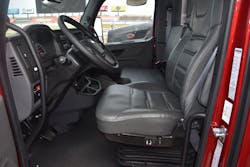Starting from scratch. Back to the drawing board. Rethinking this whole thing. A clean sheet.
Phil Hall, Peterbilt medium-duty marketing manager, used those very phrases to introduce the red oval brand’s new medium-duty lineup to a half-dozen truck editors. That was just before we were to get behind the wheel for a few demo-drive laps in some new trucks on the infield course at the Texas Motor Speedway.
He had set the bar high — always a good pitch.
Amping up the anticipation: The reset was necessary even though, as Hall reported, a whopping 95% of the medium-duty trucks Peterbilt has sold in the past 25 years are still in service.
OK so, like, why?
“All right, we need to just put our expertise to the side, and let's rethink this whole thing,” he recalled. “Because we see a market changing; we see the customers changing. We need to understand that.”
Click here to subscribe to FleetOwner Newsline to get the latest updates on the trucking industry.
Peterbilt's MD lineup answers the call
Indeed, the medium-duty truck market has evolved—and the new Peterbilt lineup has been reimagined to meet the needs of the growing demand from the pickup and delivery segment and truck rental and leasing companies, which together now account for more than two-thirds of the market, Hall explained.
Simply, trucks built to suit specialty applications serving the construction industry, for instance, were a little too narrow for the changing market. Still: Let’s start over?
The fresh approach was based on “human-centered design,” a “qualitative” process that involves the human perspective in every aspect of the product development, Hall emphasized — and he seems, by nature, to be emphatic. Or maybe “enthusiastic” is the better word. But the keyword in this process, he suggested, is "empathy."
“What we were very good at was the quantitative processes: We were good at sightlines, step heights, visibility studies, weights, analytics,” Hall said. “So we went to the source of the key information—that is the drivers, the customers. And we sat with them, we drove with them; we spent days with them doing their job to understand how they perform it.”
Again: Yo, Phil: Ever heard of that baby-bathwater thing?
But that input led to the initial round of “right, rapid and rough” prototyping — after which driver interaction was the basis for the next iterative steps. Yet throughout the process the focus areas were uptime, efficiency, versatility, technology, and productivity. And those are areas Peterbilt knows a little about.
A place for everything
Hall, who was named marketing manager a little more than a year ago, has spent nearly all of his 25-year career with Peterbilt “in the styling world,” becoming chief designer in 2014.
He spoke of being part of that design team in the early stages of development of the new trucks, “coming up with some ideas and concepts and dreaming the impossible.” His presentation also included some sketches, or “doodles,” of medium-duty truck concepts — but the sketches were just a starting point. A real-world product is all about the details: Could it be manufactured efficiently? How would the driver feel working with the truck on the job site every day? Could it be maintained efficiently? So style counts, sure, but work trucks have to work — for the manufacturer, the customer, and the dealer.
Indeed, I first met Hall in 2015 when he gave the trucking press a backstage pass to the Engineering Lab at the Denton plant, where the discussion covered the gamut from computational fluid dynamics calculations to clay models and back, and finally to details like the feel of hood latches and fabric swatches. He cared about these details—a lot. He hasn’t changed, although his job title is somewhat more elevated.
In a walkaround, Hall punched, kicked, scratched and slammed a Legendary Red Model 536, explaining how every element was critical to the notion of the whole being much more than the sum of the parts. He spoke with enthusiasm about headlights, about kickplates, about the steps and handrails, even about the color and texture of the material on the interior panels of the doors (selected to not show dirt, because no one is happy about working in a dirty environment). And storage — don’t get Hall started, or he’ll end up passionately discussing how the edge on the dash is designed to keep objects from slipping into the front air vents.
And while the new trucks give a stylistic nod to the newly redesigned Model 579, or at least to what “Peterbilt style” means, Hall emphasized in conversations formal and informal that the new medium-duty trucks are not scaled-down versions of the Class 8 flagship. That might have been the thinking once, but no longer.
Peterbilt in action
Doing a couple of unloaded laps around the infield course at the Texas Motor Speedway offered a hint at the potential of these new trucks. The Paccar PX-7 engine paired with the new Paccar TX-8 automatic transmission proved peppy. The cab was as quiet as the adventure SUV the rental car company stuck me with for my trip to Denton — and the Model 535’s ride was certainly smoother. (I will admit that a recent self-inflicted knee problem (don’t ask) afforded a special appreciation of that new step design and grab handles on the medium-duty trucks.)
On the other hand, an afternoon at the track does not provide the same experience as riding around with a couple of other sweaty guys putting in some miles between loading and unloading the stake bed — all day, every day. (Although I can say with some certainty that the guy in the middle in that three-across seating arrangement is very happy about the cab going from 1.9 meters to 2.1.)
Of course, in the medium-duty world, the chassis is often just the “truck” part of a “work truck.”
“Our intent with vocational trucks is to make body integration as simple as possible,” said Tony Sablar, Peterbilt vocational marketing manager. “The easier we make it for a body to be installed on our chassis, then the better reliability our truck will provide by the time it gets to the customer.” (See the May issue of Trailer/Body BUILDERS for an extended discussion with Sablar on the various medium duty improvements aimed at truck equipment manufacturers.)
See the slides above for more insight on what a truck built around "empathy" looks like.
About the Author
Kevin Jones
Editor
Kevin has served as editor-in-chief of Trailer/Body Builders magazine since 2017—just the third editor in the magazine’s 60 years. He is also editorial director for Endeavor Business Media’s Commercial Vehicle group, which includes FleetOwner, Bulk Transporter, Refrigerated Transporter, American Trucker, and Fleet Maintenance magazines and websites.
Working from Beaufort, S.C., Kevin has covered trucking and manufacturing for nearly 20 years. His writing and commentary about the trucking industry and, previously, business and government, has been recognized with numerous state, regional, and national journalism awards.



